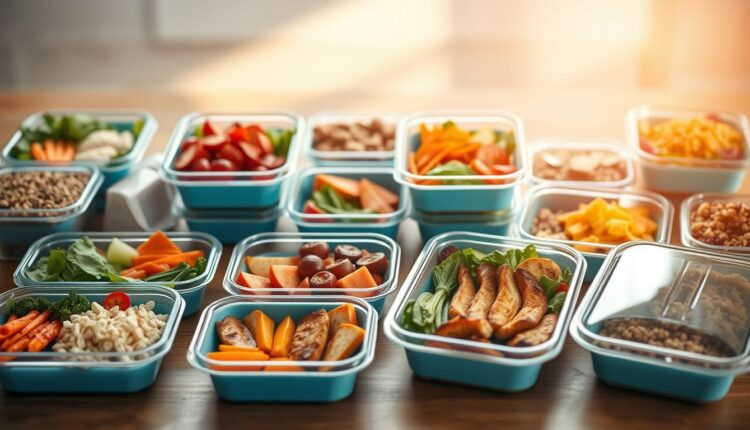Lunch Meal Prep Custom Variations For Personal Preferences
simple lunch meal prep custom variations to suit your taste and dietary needs. Learn how to prep ahead for stress-free meals.
Three years ago, I found myself staring at another identical container of roasted chicken and quinoa. Sound familiar? That’s when I realized: rigid routines lead to kitchen burnout. But here’s the good news—your midday plate doesn’t have to feel like a rerun.
This guide grew from my own experiments (and a few Instagram-fueled “aha!” moments) to help you build a mix-and-match system. Whether you’re juggling dietary needs or just craving fresh flavors, strategic ingredient swaps can transform your routine. I’ll share how to create six distinct dishes from three base components—no fancy skills required.
- Design meals around your unique schedule and taste buds
- Use smart batch cooking to maximize freshness
- Prevent flavor fatigue with texture-focused combos
We’ll focus on practical building blocks—proteins that stay juicy, grains that keep their bite, and dressings that brighten everything. Forget rigid recipes. Instead, think of your fridge as a flavor playground where roasted sweet potatoes might become tacos today and grain bowls tomorrow.
Mix and Match Meal Prep
Variety in your weekly rotation isn’t about cooking more—it’s about combining smarter. Mix-and-match systems work like building blocks: 3 core elements create 6+ unique dishes. I discovered this after burning out on my “perfect” meal plan that left me craving takeout by Wednesday.
The Basics of Meal Components
Every balanced plate needs three friends:
| Base | Protein | Flavor Boosters |
|---|---|---|
| Quinoa | Shredded chicken | Lime-cilantro dressing |
| Brown rice | Marinated tofu | Chili-garlic oil |
| Mixed greens | Spiced chickpeas | Tahini drizzle |
Cook these staples in batches each Sunday. Store them separately to maintain textures. Grains stay fluffy when kept away from dressings, and proteins stay juicy in airtight containers.
How Customization Enhances Variety
That shredded chicken? Monday’s tacos become Thursday’s curry bowl with two swaps. Try these easy upgrades:
- Swap dressings: Go from Mediterranean (lemon-oregano) to Asian (ginger-sesame)
- Change cooking methods: Roast veggies vs. quick-pickle them
- Add crunch: Toasted nuts or crispy chickpeas transform mouthfeel
One client turned her basic grain bowl into five meals using different spice blends. “It feels like I’m eating out,” she told me. That’s the power of strategic mixing.
Benefits of Customizing Your Lunch Meal Prep
The magic of personalized meal systems lies in their flexibility. Imagine transforming basic ingredients into five distinct dishes without extra cooking time. Studies show prepped components can cover two-thirds of weekly needs when used strategically.

- Flavor freedom: Swap dressings or cooking methods to avoid taste burnout
- Nutritional balance: Rotate colorful veggies and proteins for broader nutrient intake
- Time efficiency: Reconfigure prepped items in minutes—ideal for hectic days
One reader shared how dairy-free breakfast prep principles helped her adapt lunches for lactose intolerance. “Now I make one batch of roasted veggies that becomes stir-fry, wraps, and salad toppings,” she explained.
Creative combinations keep things exciting. Try turning shredded chicken into:
- BBQ lettuce cups (Monday)
- Curry salad wraps (Wednesday)
- Grain bowl toppers (Friday)
This method reduces food waste too. Leftover quinoa becomes fried “rice,” while extra greens blend into smoothies. As I often tell my cooking class students: “Your fridge should work for you, not the other way around.”
Setting Up Your Meal Prep Essentials
Your kitchen toolkit determines whether you’ll dread Mondays or greet them with ready-to-go options. I learned this the hard way when my early attempts at batch cooking left me with soggy grains and wilted greens. Let’s fix that.
Choosing Grains, Bases, and Wraps
Start with sturdy foundations. Quinoa and brown rice hold up for 4-5 days when stored properly. For wraps, spinach varieties add color and nutrients without overwhelming flavors. Compare options:
| Base Type | Prep Time | Best Use |
|---|---|---|
| Quinoa | 15 mins | Grain bowls, stuffed peppers |
| Whole wheat tortillas | N/A | Quick wraps, breakfast burritos |
| Butter lettuce | 2 mins | Low-carb lettuce cups |
Store bases separately from dressings. Glass containers keep wraps pliable, while cooked grains stay fluffy in shallow bins.
Selecting Proteins and Fresh Veggies
Rotate between three protein sources weekly. Grilled chicken thighs outperform breasts for juiciness, while marinated tempeh satisfies plant-based needs. For vegetables:
- Crunchy: Bell peppers, snap peas
- Roast-friendly: Zucchini, Brussels sprouts
- Quick-prep: Baby spinach, cherry tomatoes
“Invest in seasonal produce—it’s cheaper and lasts longer. Frozen works too for busy weeks!”
Pair proteins with contrasting textures. Shredded chicken loves crisp veggies, while soft tofu shines with roasted squash. Your local farmer’s market often has bulk deals on staples.
Exploring a Variety of Meal Prep Components
Ever opened your fridge to find five containers of the same roasted veggies? That changed for me when I started viewing ingredients as puzzle pieces. Your weekly lineup should include six core elements:
- Bases: Farro holds dressings better than rice, while massaged kale stays crisp
- Proteins: Try shredded pork shoulder or black bean burgers for texture contrast
- Veggies: Combine roasted roots with raw radishes for crunch
- Sauces: Miso-tahini or avocado crema transform flavors instantly
- Toppers: Everything-bagel spice or crushed wasabi peas add excitement
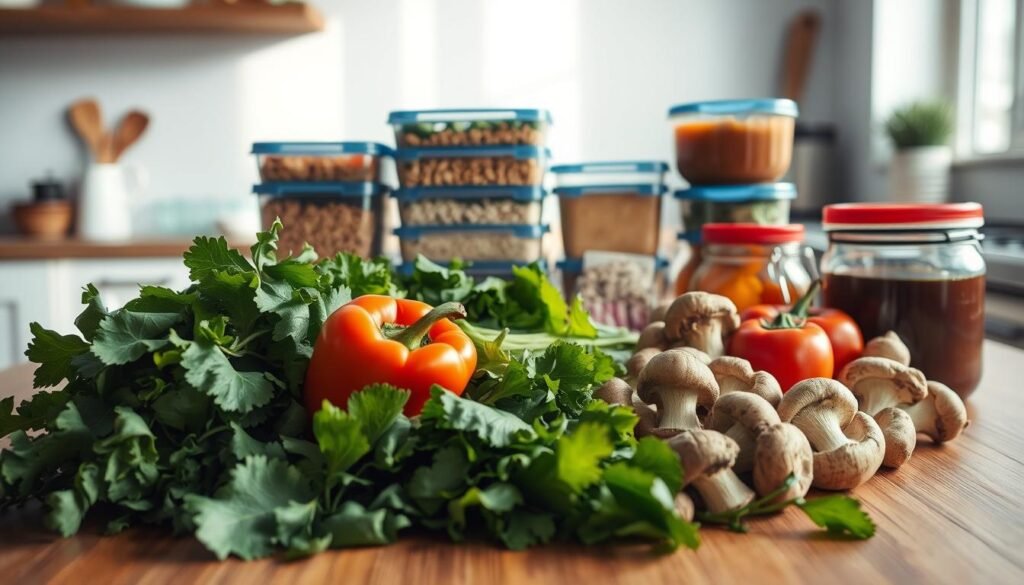
These elements become your building blocks. Check how three items create multiple dishes:
| Component | Monday | Thursday |
|---|---|---|
| Shredded chicken | BBQ wrap | Curry grain bowl |
| Quinoa | Stuffed pepper | Breakfast hash |
| Lemon dressing | Green salad | Marinated tofu |
One client’s “boring” spinach became:
- Salad base with strawberries
- Wilted into lentil soup
- Blended into green goddess dip
“Don’t just make components—make conversation starters. Your sweet potato could be fries today and taco filling tomorrow.”
Try swapping just one element weekly. Replace your usual ranch with green goddess dressing, or trade walnuts for spiced pepitas. These small shifts keep your rotation feeling fresh without extra work.
Implementing Lunch Meal Prep Custom Variations
Ever felt overwhelmed by meal prep routines? The secret lies in treating your fridge like a toolkit. Here’s how to build midday dishes without repeating flavors:
- Protein: Lemon-herb chicken and sesame-glazed tofu
- Base: Farro or cauliflower rice
- Veggies: Roasted broccoli plus raw bell pepper strips
Store these separately. Each morning, grab one item from each category and add a sauce or crunch. Check how three ingredients create five meals:
| Protein | Base | Veggie | Meal Idea |
|---|---|---|---|
| Chicken | Farro | Broccoli | Warm grain bowl with tahini |
| Tofu | Cauliflower rice | Peppers | Asian-style lettuce wraps |
| Chicken + Tofu | Mixed bases | Both veggies | Sheet pan stir-fry |
I once helped a busy dad transform shredded pork into three dishes: tacos, fried rice, and salad. “Changing the sauce made it feel new each day,” he shared. That’s the power of strategic mixing.
“Your components should be like building blocks—versatile enough for multiple play sessions.”
Try this workflow:
- Prep bases/proteins Sunday evening
- Chop fresh veggies Wednesday for crunch
- Swap one element daily (sauce, herb, or cooking method)
Even small tweaks matter. Swap paprika for cumin in roasted veggies. Use lime instead of lemon in dressings. Your taste buds won’t know it’s the same ingredients!
Creative Mix-and-Match Strategies
My kitchen breakthrough came when I realized a simple truth: sauces are flavor superheroes. One batch of roasted veggies can taste entirely different depending on what you drizzle over them. Let’s explore how to turn basic ingredients into bold creations through strategic pairings.
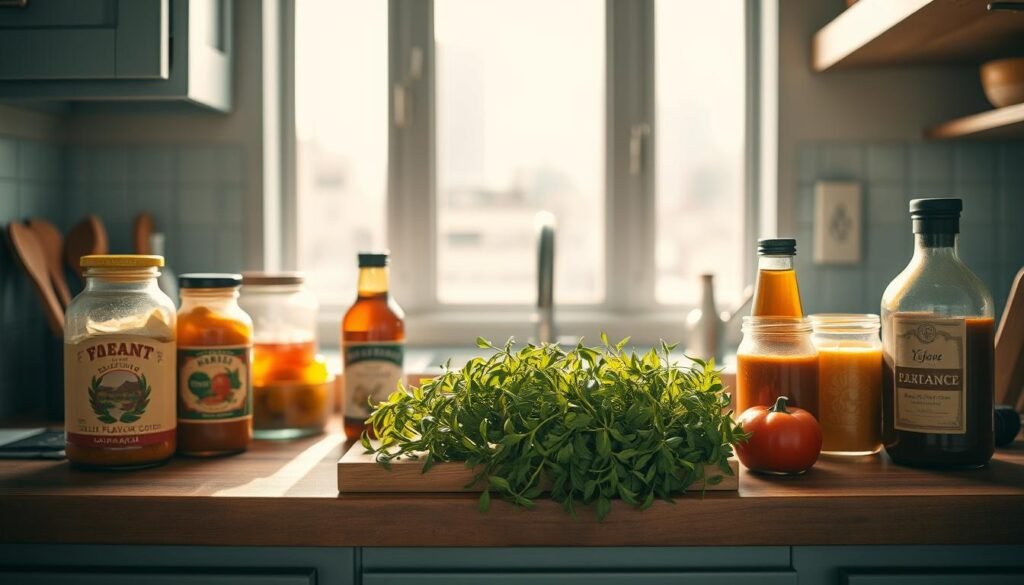
Combining Sauces, Seasonings, and Dressings
Think of your spice rack as a paint palette. Smoked paprika transforms plain chicken into Spanish-inspired fare, while curry powder sends tofu on a trip to Mumbai. Try these combos:
| Base Ingredient | Sauce/Seasoning | Resulting Dish |
|---|---|---|
| Shredded cabbage | Peanut-lime dressing | Thai-inspired slaw |
| Quinoa | Harissa + lemon | North African grain salad |
| Grilled zucchini | Balsamic glaze + chili flakes | Italian-style antipasto |
For quick upgrades, keep three sauce types ready: creamy (yogurt-based), zesty (citrus-forward), and umami-rich (soy or miso). Rotate them through your personalized meal plans to prevent flavor fatigue.
Building Unique Meal Combinations
The real magic happens when layers collide. Crunchy veggies love silky dressings, while hearty grains crave bright acids. Last week, I turned basic components into:
- Mediterranean bowl: Hummus + roasted red pepper + za’atar
- Asian fusion: Ginger dressing + sesame seeds + quick-pickled carrots
- Tex-Mex twist: Avocado crema + smoked paprika + lime
“Don’t fear bold experiments. That odd-sounding spice blend? It might become your new favorite.”
Start with small swaps. Replace regular salt with flaky sea salt. Add a pinch of cayenne to honey mustard. These tweaks keep your taste buds guessing without overhauling your routine.
Step-by-Step Guide to Preparing Your Lunch
Thursday mornings used to be chaos until I discovered component-based prep. Let’s break down how to create grab-and-go options without the scramble. This system works whether you’re feeding a family or just yourself.
Prepping Ingredients Ahead of Time
Start with a Sunday reset. Wash and chop veggies first—they’ll stay crisp in airtight containers lined with paper towels. Batch-cook grains and proteins using these time-savers:
- Roast two sheet pans of vegetables while grains simmer
- Marinate proteins in reusable silicone bags
- Portion dressings in small jars to prevent sogginess
Group similar tasks. Chop all onions at once, then wipe the cutting board once. Store components at eye level so you’ll actually use them.
Efficient Assembly Methods for the Week
Mornings become smoother with this trick: layer components from sturdiest to most delicate. Try this order:
- Base (grains or greens)
- Proteins
- Crunchy veggies
- Toppers in separate compartments
Use divided containers for dressings and fragile herbs. One client cut assembly time by 75% using this method. “I grab containers like puzzle pieces,” she shared.
“Organize your fridge like a buffet line—everything visible and within reach.”
Rotate one element daily to keep things fresh. Swap Monday’s cilantro-lime drizzle for Wednesday’s tahini sauce. These small changes make each day feel distinct without extra work.
Quick and Easy Recipes to Get Started
The real magic happens when your prepped ingredients transform into completely different dishes throughout the week. Let’s dive into simple combinations that’ll make your fridge feel like a restaurant kitchen.
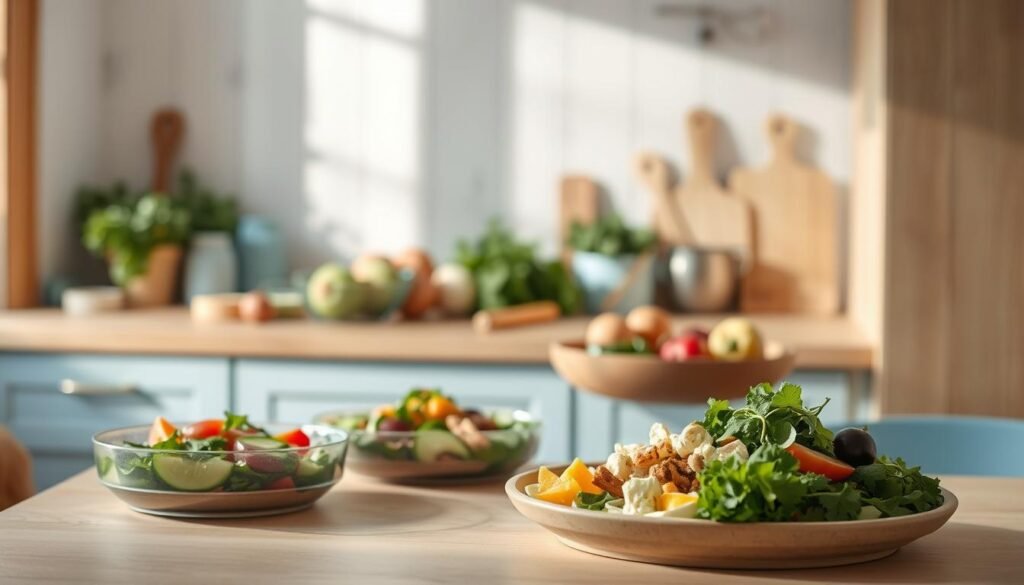
Start your morning strong with a sweet potato breakfast burrito. Scramble eggs with pre-roasted squash and spinach, then wrap in a whole-grain tortilla. Add a dash of smoked paprika for warmth. By Friday? Those same components become a veggie-packed frittata with crumbled feta.
For midday meals, try this crowd-pleaser:
| Recipe | Components | Assembly Steps |
|---|---|---|
| Lemon-Chicken Bowl | Pre-cooked rice, shredded chicken, roasted broccoli | Toss with lemon-tahini dressing + toasted almonds |
| Spicy Squash Pasta | Whole wheat noodles, caramelized squash, garlic oil | Mix with red pepper flakes + Parmesan |
| BBQ Wrap | Shredded chicken, coleslaw mix, whole wheat wrap | Drizzle with BBQ sauce + avocado slices |
“Your prepped ingredients should feel like a culinary passport—each combination takes your taste buds somewhere new.”
Need something faster? Combine pre-chopped veggies with scrambled eggs for a 5-minute skillet. Leftover rice becomes fried rice with frozen peas and a fried egg on top. The key? Keep sauces and spices within arm’s reach for instant upgrades.
These ideas prove that delicious eating doesn’t require complicated steps. Rotate your base ingredients, play with global flavors, and watch your routine meals become crave-worthy creations.
Nutritional Considerations for Balanced Meals
A client once confessed she’d eaten nothing but kale salads for a week—and felt exhausted by Friday. Her mistake? Missing the balance between fuel and flavor. Crafting nourishing meals isn’t about restriction—it’s about smart pairings that keep your body and taste buds engaged.
- Proteins: Grilled salmon or spiced lentils for sustained energy
- Greens: Spinach, arugula, or shredded Brussels sprouts for vitamins
- Healthy fats: Avocado slices or toasted walnuts for absorption
Dressings do double duty. A lemon-tahini blend adds zest while delivering calcium. Try this formula: 2 parts acid (citrus, vinegar) + 1 part oil + 1 part nutrient booster (nut butter, Greek yogurt).
Real-world example from my kitchen:
| Meal | Protein | Greens | Fat Source |
|---|---|---|---|
| Power Salad | Chickpeas | Kale | Avocado |
| Grain Bowl | Tempeh | Spinach | Pumpkin Seeds |
“Think of your plate as a clock—¼ protein, ¼ grains, ½ colorful veggies. Add a ‘flavor hand’ with dressing or herbs.”
Common question: “How do I stay full?” Combine fiber-rich bases (quinoa) with slow-digesting proteins (chicken thigh). For quick upgrades, swap iceberg lettuce for magnesium-packed spinach in salads. Small tweaks create meals that energize without boredom.
Adapting Meal Prep for Busy Lifestyles
When my twins started soccer practice, I realized traditional meal prep wasn’t cutting it anymore. The secret? Treating your kitchen like a well-oiled machine with smart shortcuts. Let’s tackle time crunches head-on with systems that work for real life.
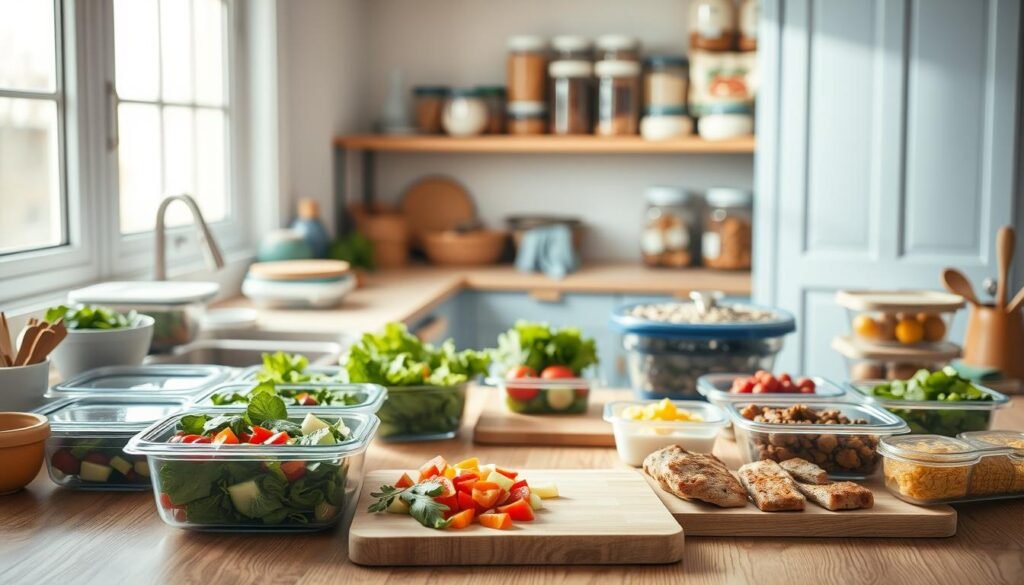
Smart Storage & Speed Strategies
Freezer-friendly containers became my weekday heroes. Try these fridge organization tips:
- Label mason jars with dates and contents (soups, chopped veggies)
- Use foil wraps for pre-portioned proteins ready to bake
- Store sandwich fillings in divided trays (hummus separate from veggies)
Leftover rice gets new life in minutes. See how three batches create multiple dishes:
| Rice Type | Day 1 | Day 3 | Day 5 |
|---|---|---|---|
| Jasmine | Stir-fry base | Stuffed peppers | Breakfast porridge |
| Brown | Grain bowls | Veggie burgers | Soup thickener |
“Your freezer isn’t just for ice cream—it’s your ticket to stress-free Wednesday dinners.”
One working mom shared her win: “Pre-chopped veggies in glass containers cut my cooking time in half.” Rotate components weekly to keep things fresh without extra effort. Sunday’s roasted sweet potatoes become Tuesday’s tacos and Friday’s hash.
Remember: sustainable habits beat perfection. Start with one freezer meal and build from there. Your future self will thank you during hectic weeks.
Incorporating Fresh and Leftover Ingredients
Your fridge holds more potential than you think—those lingering veggies and grains could become tomorrow’s star dish. I learned this when a client transformed wilting spinach into vibrant pesto, proving leftovers aren’t dead ends but launchpads for creativity.
Repurpose ingredients like a pro. Last week’s quinoa becomes today’s breakfast bowl when paired with fresh berries and yogurt. Try these smart swaps:
- Revive roasted veggies by tossing them into omelets or grain salads
- Blend overripe avocado into creamy dressings or spread on wraps
- Mix cooked spinach with garlic and chickpeas for a protein-packed dip
Here’s how to combine stored components with new finds:
| Leftover Ingredient | Fresh Addition | New Creation |
|---|---|---|
| Quinoa | Cucumber + mint | Mediterranean salad |
| Spinach | Strawberries + feta | Sweet-savory side |
| Avocado | Lime + cilantro | Zesty toast topping |
“Leftovers aren’t limitations—they’re opportunities waiting for a flavor twist.”
Spot peak freshness: crisp veggies work raw, while softer ones shine in cooked dishes. Store herbs stems-down in water to extend their life. This approach cuts grocery trips and lets you savor ingredients at their best.
Need inspiration? Fold leftover quinoa into burger patties, or blend spinach into smoothies with frozen mango. Your wallet and taste buds will thank you.
Creative Ideas for Sides and Snacks with Meal Prep
What if your snacks became the highlight of your day? I discovered this when a client transformed leftover roasted carrots into sweet-spiced energy bites. Your fridge holds endless possibilities for quick, flavorful additions to any plate.
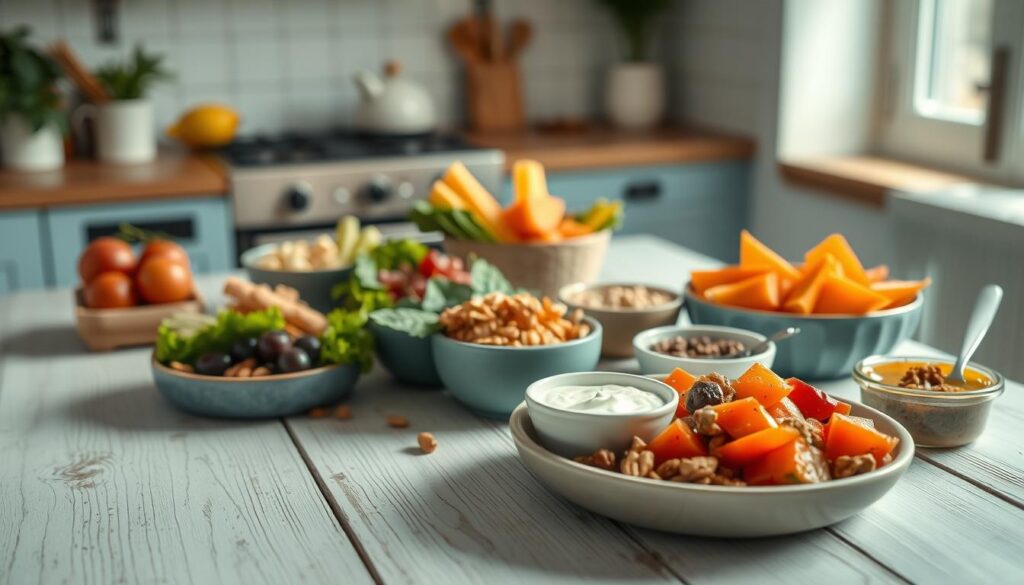
| Base | Add-In | Topping | Snack Idea |
|---|---|---|---|
| Hummus | Za’atar spice | Toasted pine nuts | Mediterranean dip with cucumber sticks |
| Greek yogurt | Honey + cinnamon | Crushed walnuts | Sweet & crunchy parfait |
| Guacamole | Diced mango | Chili-lime pepitas | Tropical chips companion |
Crunchy elements make all the difference. Keep portioned bags of almonds or spiced chickpeas handy. Toss them into salads or eat solo for quick protein boosts.
Leftovers become next-level sides. That quinoa from Tuesday’s bowl? Mix with diced apples and curry powder for a chilled salad. Stale bread transforms into croutons when baked with olive oil and rosemary.
“Treat your snack drawer like a treasure chest—every combination should spark joy.”
Smart storage tips:
- Use silicone muffin cups to separate trail mix components
- Store cut veggies upright in water-filled jars
- Freeze herb portions in olive oil cubes
Experiment with texture contrasts. Pair creamy avocado slices with crispy jicama sticks. Mix soft roasted beets with crunchy sunflower seeds. Your taste buds will never guess these started as simple fridge staples.
Adapting Meal Prep to Your Personal Preferences
Your taste buds aren’t static—why should your meal prep be? I once worked with a client who ate grilled chicken daily until she couldn’t stand the sight of it. We shifted to rotating three proteins weekly, and her enthusiasm (and leftovers) vanished. Here’s how to keep your system feeling fresh.
Protein & Produce Rotation Strategies
Swapping ingredients prevents flavor fatigue. Try these swaps every 3-4 days:
- Proteins: Shift from turkey meatballs to marinated tempeh or lemon-pepper shrimp
- Greens: Alternate between massaged kale, butter lettuce, and arugula
- Crunch: Swap jicama sticks for radishes or sugar snap peas
Seasonal vegetables offer natural variety. Summer brings zucchini noodles, while winter shines with roasted root veggies. Pair them with complementary herbs:
| Vegetable | Herb Pairing | Brightener |
|---|---|---|
| Roasted carrots | Dill + thyme | Orange zest |
| Sautéed spinach | Basil + mint | Lemon juice |
| Grilled asparagus | Tarragon + chives | Balsamic glaze |
“A squeeze of citrus or handful of fresh herbs can make yesterday’s meal feel brand new.”
Notice cravings shifting? Fold in smoked paprika instead of cumin. Swap lime for lemon in dressings. These micro-changes keep your routine dynamic without overhauling your system. One parent told me, “Changing just the sauce made my kids think they’re getting ‘new’ meals.”
Remember: There’s always another way to combine what you have. Leftover roasted chicken becomes tacos with cilantro, then curry with coconut milk. Your preferences guide the playbook—no rigid rules required.
Troubleshooting Common Meal Prep Challenges
We’ve all opened the fridge to find wilted greens and soggy grains—but here’s how to flip those fails into wins. Let’s tackle three frequent kitchen headaches and turn them into opportunities for better eating.

Problem: Browned avocado or limp veggies
Fix: Store ingredients with paper towels to absorb moisture. Revive greens by soaking them in ice water for 10 minutes. Mash avocado with lemon juice for instant spread.
When flavors fall flat, reach for these rescuers:
- Boost bland proteins with a pinch of smoked paprika or citrus zest
- Revive overcooked grains using broth instead of water during reheating
- Add texture with toasted seeds or quick-pickled onions
| Ingredient | Storage Tip | Second Life |
|---|---|---|
| Overripe tomatoes | Freeze for sauces | Blend into gazpacho |
| Stale bread | Keep in airtight bag | Make croutons or breadcrumbs |
| Soggy greens | Wrap in damp cloth | Sauté with garlic |
“Mistakes are your best teachers. That over-salted soup? Thin it with coconut milk and call it ‘curry-inspired’!”
For time-crunched days, keep emergency fixes handy. Stir a beaten egg into watery soup to thicken it. Toss overcooked chicken with chili flakes and lime for tacos. Season strategically—add black pepper last to preserve its kick.
Remember: Proper planning prevents 80% of issues. Label containers with dates, rotate older items to the front, and designate a “use first” shelf. Your future self will thank you.
Inspiration from Successful Meal Preppers
Sarah from Minneapolis cracked the code by rotating three sauces weekly. “A simple swap of basil pesto for peanut sauce transformed my chicken into two completely different dishes,” she shared. Her story reveals a universal truth: sustainable routines thrive on shared wisdom.
Real Wins From Real Kitchens
Take Mark, a nurse working night shifts. He stores pre-portioned proteins in foil packets for quick reheating. “I grab a chicken packet and pair it with whatever grain I prepped,” he explains. This system lets him build tacos or grain bowls in 90 seconds flat.
Consider these field-tested strategies:
- Swap 1 herb weekly (cilantro ➔ dill) to refresh familiar dishes
- Use divided containers for salad toppings to maintain crunch
- Label fridge shelves by day to streamline decision-making
“Start with what excites you—if you love roasted peppers, build three meals around them first.”
Parenting blogger Jenna involves her kids in Saturday prep sessions. “They create ‘flavor match’ combos like cinnamon-sweet potato wraps,” she says. This approach cut their weekly sandwich consumption by half while expanding everyone’s palate.
These stories prove that lasting success comes through adaptation, not perfection. Your turn: try one new sauce this week. Notice how it changes your relationship with prepped ingredients.
Your kitchen journey doesn’t end here—it evolves. Through smart swaps and strategic mixing, you’ve discovered how three components can become six vibrant dishes. Remember: the best food routines adapt to your life, not the reverse.
Keep dressings bold and textures varied. A zesty lemon drizzle transforms roasted veggies today, while chili oil kicks up tomorrow’s noodles. Busy day? Toss prepped ingredients into a bowl with toasted pepitas for instant satisfaction.
Share your wins with fellow flavor explorers. Did smoked paprika rescue bland chicken? Did rainbow peppers brighten your grain base? Tag @Prepistry on Instagram—we celebrate real kitchen victories, not perfection.
Now grab those containers and play. Your next masterpiece might be a five-minute wrap or herb-kissed stir-fry. As I tell my students: “Great food happens when you mix planning with curiosity.” Let your fridge become the ultimate creativity lab—one delicious day at a time.
Ginger-Lime Tempeh Rainbow Bowls with Coconut Rice
A vibrant and nourishing vegan bowl featuring sticky ginger-lime tempeh served over fragrant coconut rice, accompanied by a medley of colorful vegetables. Perfect for a wholesome lunch or dinner.
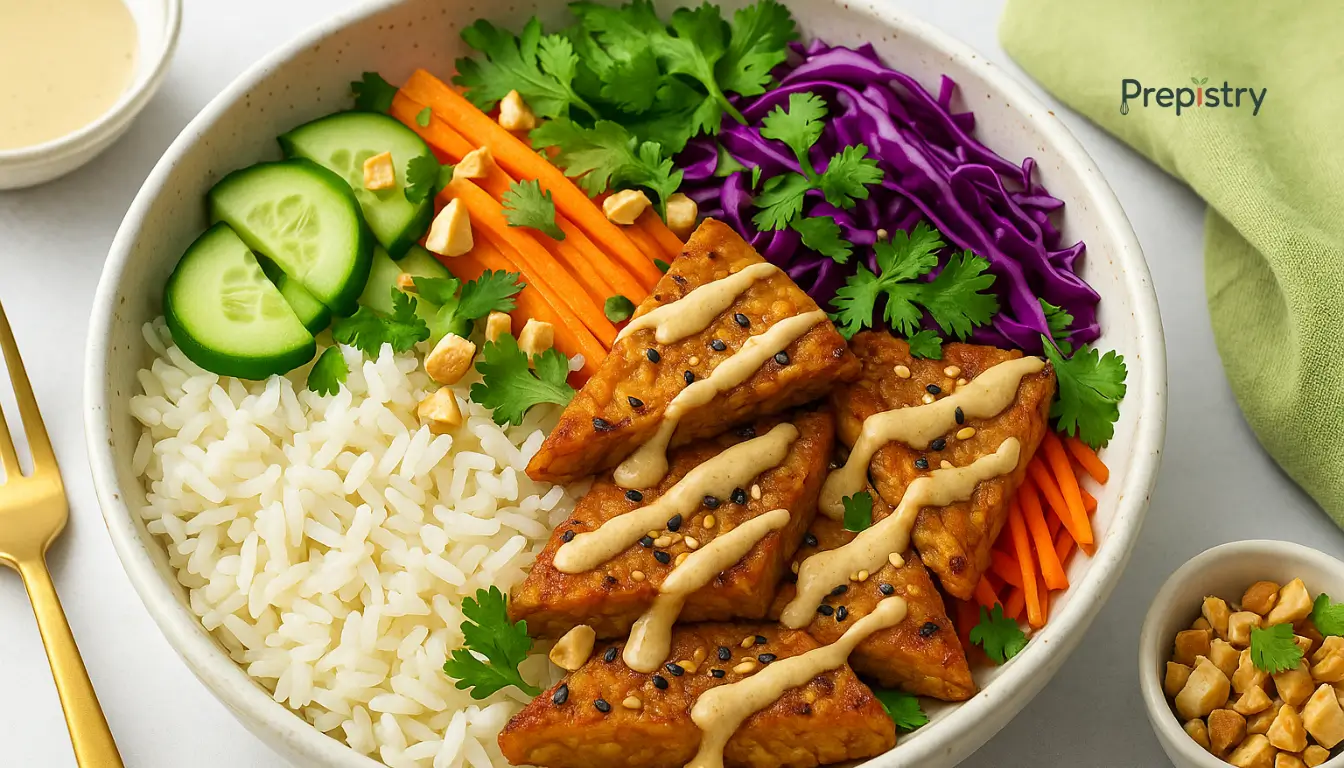
Nutrition Information
Equipment Needed
- Medium saucepan
- Large skillet
- Mixing bowls
- Wooden spoon
- Knife
- Cutting board
Ingredients
-
1 cup brown basmati rice, rinsed
-
1 cup full-fat coconut milk
-
1 cup water
-
1 tsp coconut sugar
-
1/2 tsp sea salt
-
1/2 tsp lime zest
-
1 tsp lime juice
-
8 oz tempeh, cut into 1-inch cubes
-
1/4 cup tamari
-
2 tbsp coconut sugar
-
1 tbsp hot sauce (optional)
-
1 tbsp lime juice
-
1 tbsp avocado oil
-
2 inches fresh ginger, minced
-
2 cloves garlic, minced
-
1 cup shredded red cabbage
-
1 cup julienned carrots
-
1 cup steamed broccoli florets
-
1/4 cup chopped fresh cilantro
-
Lime wedges, for serving
Instructions
Recipe Video
Sticky Ginger Tempeh with Coconut Rice
A super easy and flavourful week night meal! Crumbles of sticky ginger tempeh are coated in a delicious sauce and served over mellow coconut basmati rice.

